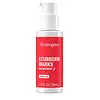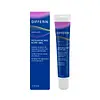What's inside
What's inside
 Key Ingredients
Key Ingredients

 Benefits
Benefits

 Concerns
Concerns

No concerns
 Ingredients Side-by-side
Ingredients Side-by-side

Water
Skin ConditioningPentaerythrityl Tetraethylhexanoate
EmollientDimethicone
EmollientGlycerin
HumectantPPG-15 Stearyl Ether
EmollientStearyl Alcohol
EmollientCetearyl Alcohol
EmollientButylene Glycol
HumectantCeteareth-20
CleansingIsohexadecane
EmollientDimethicone Crosspolymer
Emulsion StabilisingTrisiloxane
Skin ConditioningPhenoxyethanol
PreservativeCaprylyl Glycol
EmollientAmmonium Acryloyldimethyltaurate/Vp Copolymer
Polyacrylamide
C13-14 Isoparaffin
EmollientChlorphenesin
AntimicrobialHydrolyzed Myrtus Communis Leaf Extract
Skin ProtectingPolysorbate 20
EmulsifyingBHT
AntioxidantRetinol
Skin ConditioningDisodium EDTA
Sodium Hyaluronate
HumectantAscorbic Acid
AntioxidantLaureth-7
EmulsifyingSodium Hydroxide
BufferingWater, Pentaerythrityl Tetraethylhexanoate, Dimethicone, Glycerin, PPG-15 Stearyl Ether, Stearyl Alcohol, Cetearyl Alcohol, Butylene Glycol, Ceteareth-20, Isohexadecane, Dimethicone Crosspolymer, Trisiloxane, Phenoxyethanol, Caprylyl Glycol, Ammonium Acryloyldimethyltaurate/Vp Copolymer, Polyacrylamide, C13-14 Isoparaffin, Chlorphenesin, Hydrolyzed Myrtus Communis Leaf Extract, Polysorbate 20, BHT, Retinol, Disodium EDTA, Sodium Hyaluronate, Ascorbic Acid, Laureth-7, Sodium Hydroxide
Water
Skin ConditioningDimethicone
EmollientDimethicone Crosspolymer
Emulsion StabilisingCaprylic/Capric Triglyceride
MaskingBis-PEG-12 Dimethicone
EmollientGlyceryl Oleate Citrate
EmulsifyingEthoxydiglycol
HumectantBakuchiol
AntimicrobialDextran
Hippophae Rhamnoides Fruit Oil
Skin ProtectingHippophae Rhamnoides Seed Oil
Skin ProtectingAsiatic Acid
Skin ConditioningAsiaticoside
AntioxidantRosa Rubiginosa Seed Oil
EmollientButylene Glycol
HumectantHydrogenated Ethylhexyl Olivate
EmollientPhenoxyethanol
PreservativeAcrylates/C10-30 Alkyl Acrylate Crosspolymer
Emulsion StabilisingCitric Acid
BufferingSodium Hydroxide
BufferingTocopheryl Acetate
AntioxidantEthylhexylglycerin
Skin ConditioningDisodium EDTA
Squalane
EmollientMadecassic Acid
Skin ConditioningTripeptide-1
Skin ConditioningWater, Dimethicone, Dimethicone Crosspolymer, Caprylic/Capric Triglyceride, Bis-PEG-12 Dimethicone, Glyceryl Oleate Citrate, Ethoxydiglycol, Bakuchiol, Dextran, Hippophae Rhamnoides Fruit Oil, Hippophae Rhamnoides Seed Oil, Asiatic Acid, Asiaticoside, Rosa Rubiginosa Seed Oil, Butylene Glycol, Hydrogenated Ethylhexyl Olivate, Phenoxyethanol, Acrylates/C10-30 Alkyl Acrylate Crosspolymer, Citric Acid, Sodium Hydroxide, Tocopheryl Acetate, Ethylhexylglycerin, Disodium EDTA, Squalane, Madecassic Acid, Tripeptide-1
 Reviews
Reviews

Ingredients Explained
These ingredients are found in both products.
Ingredients higher up in an ingredient list are typically present in a larger amount.
Butylene Glycol (or BG) is used within cosmetic products for a few different reasons:
Overall, Butylene Glycol is a safe and well-rounded ingredient that works well with other ingredients.
Though this ingredient works well with most skin types, some people with sensitive skin may experience a reaction such as allergic rashes, closed comedones, or itchiness.
Learn more about Butylene GlycolDimethicone is a type of synthetic silicone created from natural materials such as quartz.
What it does:
Dimethicone comes in different viscosities:
Depending on the viscosity, dimethicone has different properties.
Ingredients lists don't always show which type is used, so we recommend reaching out to the brand if you have questions about the viscosity.
This ingredient is unlikely to cause irritation because it does not get absorbed into skin. However, people with silicone allergies should be careful about using this ingredient.
Note: Dimethicone may contribute to pilling. This is because it is not oil or water soluble, so pilling may occur when layered with products. When mixed with heavy oils in a formula, the outcome is also quite greasy.
Learn more about DimethiconeDimethicone Crosspolymer is a silicone created by modifying dimethicone with hydrocarbon side chains. Due to its large size, it does not penetrate skin. It is considered non-occlusive.
Dimethicone Crosspolymer is used to stabilize and thicken products. It also helps give products a silky feel.
Disodium EDTA plays a role in making products more stable by aiding other preservatives.
It is a chelating agent, meaning it neutralizes metal ions that may be found in a product.
Disodium EDTA is a salt of edetic acid and is found to be safe in cosmetic ingredients.
Learn more about Disodium EDTAPhenoxyethanol is a preservative that has germicide, antimicrobial, and aromatic properties. Studies show that phenoxyethanol can prevent microbial growth. By itself, it has a scent that is similar to that of a rose.
It's often used in formulations along with Caprylyl Glycol to preserve the shelf life of products.
Sodium Hydroxide is also known as lye or caustic soda. It is used to adjust the pH of products; many ingredients require a specific pH to be effective.
In small amounts, sodium hydroxide is considered safe to use. However, large amounts may cause chemical burns due to its high alkaline.
Your skin has a natural pH and acid mantle. This acid mantle helps prevent harmful bacteria from breaking through. The acid mantle also helps keep your skin hydrated.
"Alkaline" refers to a high pH level. A low pH level would be considered acidic.
Learn more about Sodium HydroxideWater. It's the most common cosmetic ingredient of all. You'll usually see it at the top of ingredient lists, meaning that it makes up the largest part of the product.
So why is it so popular? Water most often acts as a solvent - this means that it helps dissolve other ingredients into the formulation.
You'll also recognize water as that liquid we all need to stay alive. If you see this, drink a glass of water. Stay hydrated!
Learn more about Water